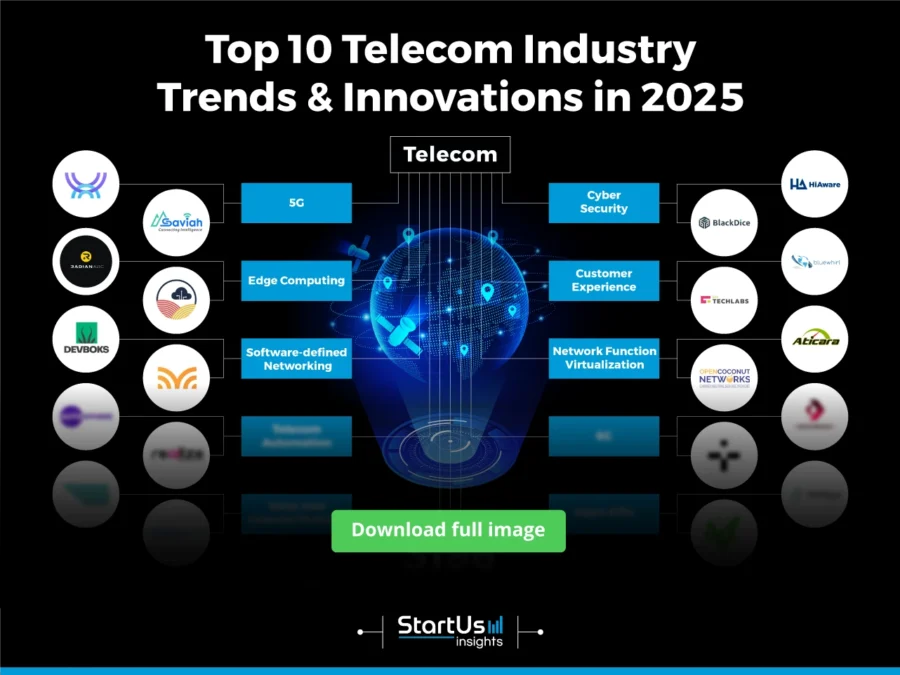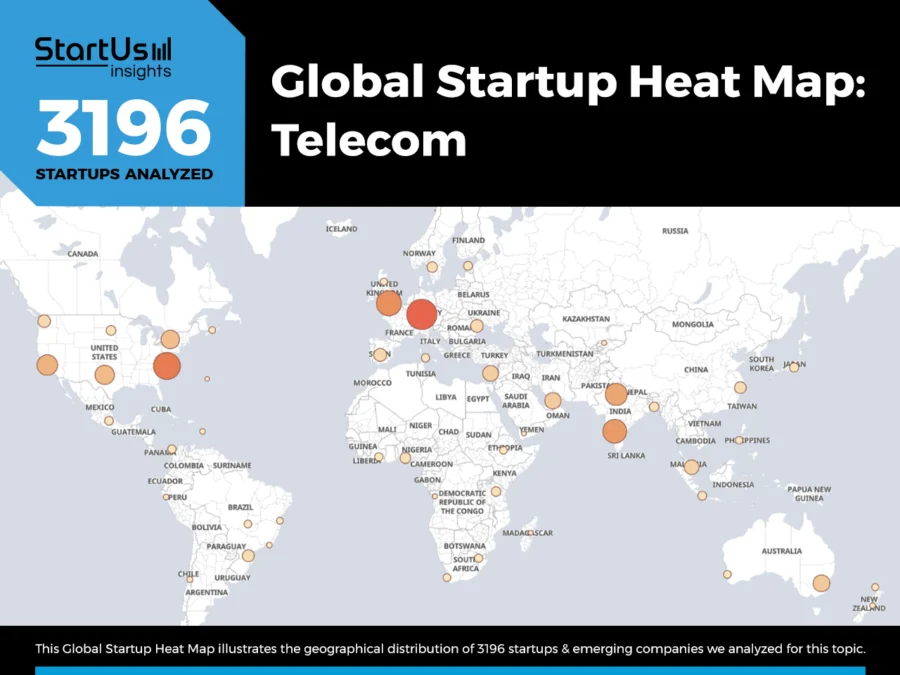The telecom industry is advancing rapidly driven by the need for higher data capacity, ultra-low latency, and enhanced network resilience.
Emerging technologies such as 5G, edge computing, artificial intelligence (AI)-driven network management, and Internet of Things (IoT) enhance communication infrastructures. These innovations enable telecom providers to optimize network performance, improve automation, and deliver new service models across industries.
This report explores the top 10 telecom industry trends and innovations for 2025 – highlighting how various technologies are accelerating the sector’s evolution and redefining its role in forming a hyper-connected digital landscape.
What are the Top Telecom Trends for 2025?
- 5G
- Edge Computing
- Software Defined Network (SDN)
- Telecom Automation
- Voice Over Internet Protocol (VoIP)
- Cybersecurity
- Customer Experience
- Network Function Virtualization (NFV)
- 6G
- Business Support Systems (BSS) and Operational Support Systems (OSS)
Methodology: How We Created the Telecom Trend Report
For our trend reports, we leverage our proprietary StartUs Insights Discovery Platform, covering 5M+ global startups, 20K technologies & trends plus 150M+ patents, news articles, and market reports.
Creating a report involves approximately 40 hours of analysis. We evaluate our own startup data and complement these insights with external research, including industry reports, news articles, and market analyses. This process enables us to identify the most impactful and innovative trends in the telecom industry.
For each trend, we select two exemplary startups that meet the following criteria:
- Relevance: Their product, technology, or solution aligns with the trend.
- Founding Year: Established between 2020 and 2025.
- Company Size: A maximum of 200 employees.
- Location: Specific geographic considerations.
This approach ensures our reports provide reliable, actionable insights into the telecommunication innovation ecosystem while highlighting startups driving technological advancements in the industry.
Innovation Map outlines the Top 10 Telecommunications Industry Trends & 20 Promising Telecom Startups
For this in-depth research on the Top Telecommunication Trends & Startups, we analyzed a sample of 3100+ global startups & scaleups. The Telecommunication Innovation Map created from this data-driven research helps you improve strategic decision-making by giving you a comprehensive overview of the telecommunication industry trends & startups that impact your company.

Tree Map reveals the Impact of the Top 10 Trends in Telecommunication
Based on the Telecommunication Industry Innovation Map, the Tree Map below illustrates the impact of the Top 10 Telecom Industry Trends like edge computing, telecom automation, 6G, cybersecurity, and more. We have examined 3196 startups from different regions around the world. This examination includes insights like which trend the startup is working on, the products/services being built, how it aids the telecommunication sector, etc. These insights assist in making a more aligned and strategy-driven decision.

Global Startup Heat Map covers 3196 Telecom Startups & Scaleups
The Global Startup Heat Map showcases the distribution of 3100+ exemplary startups and scale-ups analyzed using the StartUs Insights Discovery Platform. It highlights high startup activity in Western Europe and the USA, followed by India. From these, 20 promising startups are featured below, selected based on factors like founding year, location, and funding.
Want to Explore Telecom Innovations & Trends?
Top 10 Emerging Trends in Telecom Industry (2025 & Beyond)
1. 5G
5G is known for its speed, low latency, capacity, and bandwidth. These features improve the efficiency of telecommunication in handling usage spikes and unpredictable network traffic.
The global 5G technology ROI market size is predicted to increase from USD 129.65 billion in 2025 to approximately USD 114 486 billion by 2034, expanding at a compound annual growth rate (CAGR) of 114.05% from 2025 to 2034.
![Top 10 Telecom Industry Trends [2025 & Beyond] | StartUs Insights](https://www.startus-insights.com/wp-content/uploads/2024/10/5g-technology-roi-market-size-900x506.webp)
Credit: Precedence Research
Additionally, 5G provides reliable connections among multiple IoT devices and assists in developing smart industries and remote monitoring across sectors. 5G also improves the user experience of content consumption, such as streaming live events.
Vaan Megam streamlines 5G Application Testing & Deploying
Vaan Megam is an Indian startup that provides a 5G lab-as-a-service platform that facilitates testing of protocols, performance, and latency.
The company uses real-world conditions through its realistic test bed and delivers accurate assessments for telecom operators, equipment manufacturers, and application developers.
It provides detailed reporting, test scheduling, monitoring, and value-added services like logging, resuming crashes, and rerunning on failure. This allows businesses to deploy high-quality 5G solutions without investing in expensive infrastructure.
Saviah Technologies provides 5G Core (5GC) Networks
Taiwanese startup Saviah Technologies provides 5GC in three variations: lightweight, industry-grade, and carrier-grade. These 5GC networks are used for various purposes, such as telecom technology centers and virtual reality. They also improve connectivity in industries like agriculture, manufacturing, healthcare, port, media, and entertainment.
Saviah Technologies’ 5GC complies with 3GPR R15/16 standards and covers end-to-end network functions like access and mobility management, session management, user plane, authentication server, and more. It also assists in network functions like slice selection, exposure, NF repository, and policy control.
2. Edge Computing
Edge computing along with 5G induces benefits like higher bandwidth, faster response time, better decision-making, and lower latency in the telecommunication sector.
The global edge computing market size is predicted to reach around USD 5132.29 billion by 2034, growing at a CAGR of 28% from 2024 to 2034.
![Top 10 Telecom Industry Trends [2025 & Beyond] | StartUs Insights](https://www.startus-insights.com/wp-content/uploads/2024/10/edge-computing-market-size-900x533.webp)
Credit: Precedence Research
Telecom providers use edge computing to improve horizontal platform functionalities by segregating it into three layers: connectivity, hardware, and value-added services. It also enhances network resilience with a decentralized structure, which allows multiple nodes to work independently.
As edge nodes are capable of local data processing, telecom operators are able to maintain service continuity even when the connectivity to central servers is compromised.
Rural Cloud Initiative offers Edge Computing for Rural Areas
Rural Cloud Initiative is a US-based startup that delivers edge computing solutions for improving data processing capabilities in rural communities.
Its proprietary platforms EdgeHub, EdgeGate, EdgeRan, and EdgeSite provide virtual networks and connectivity along with data storage and analysis.
This arrangement assists in enterprise LTE networks, 5G networks, edge storage, video analytics, industrial automation, and drone operations.
Radian Arc provides Cloud Gaming & SDN Services
Radian Arc is an Australian startup that offers GPU computing, storage, and networking infrastructure for telecommunication service providers. The distributed GPU-based edge provides a low-latency network for improving value-added services, monetizing 5G investments, faster cloud gaming, and SDN services.
![Top 10 Telecom Industry Trends [2025 & Beyond] | StartUs Insights](https://www.startus-insights.com/wp-content/uploads/2024/10/Radian-Arc-Chairman-900x435.webp)
The low-latency network also facilitates applications like AI and machine learning. The GPU edge solutions are also available as an infrastructure-as-a-service (IaaS), a paid host of bare metal-as-a-service (BMaaS), and virtual machine-as-a-service (VMaaS).
3. Software Defined Network
SDN operates by separating the control plane that makes decisions about traffic flow from the data plane that implements that decision. For example, telecommunication companies use SDN to implement network slicing in 5G networks and create multiple virtual networks on a single physical infrastructure to support applications like IoT and high-definition video streaming.
The global software-defined networking market size was valued at USD 34.29 billion in 2023 and is projected to grow at a CAGR of 17.9% from 2024 to 2030.
![Top 10 Telecom Industry Trends [2025 & Beyond] | StartUs Insights](https://www.startus-insights.com/wp-content/uploads/2024/10/software-defined-networking-market.webp)
Credit: Grand View Research
SDN’s centralized control further simplifies network management for quicker responses to security threats. Software-defined networks improve edge computing applications, end-to-end network visibility, and bandwidth management with software-based controllers and application programming interfaces (APIs).
TelcosCloud provides AI-based Cloud Communication
Indian startup TELCOSCLOUD offers an AI-powered full-stack carrier-grade API and an OTT platform. The platform leverages a distributed computing network that utilizes automation and artificial intelligence, combining software-defined networking, virtualized infrastructure, and cloud-native technology.
The platform integrates voice, messaging, contact center, and enterprise-class API solutions into a single, secure, and reliable cloud communications platform1. TELCOSCLOUD offers various products, including messaging (SMSC), voice (Cloud Contact Center), AI-powered marketing communication, UCaaS (Unified Communications as a Service), and CPaaS (Communications Platform as a Service)1.
The platform ensures enhanced user experience, improved operational efficiency, flexibility, scalability, and cost-effectiveness.
DevBoks produces Integrable API-centric OSS/BSS Solutions
DevBoks is a South African startup that develops SDN solutions for the telecommunications industry. It automates the API-centric OSS-BSS systems.
Devboks has developed self-service graphical user interfaces and API platforms that strengthen Internet Exchange Points, ISPs, and telecom operations.
It addresses network issues through self-maintaining capabilities. The company’s approach uses DevOps, system reliability engineering, and agile methodologies to ensure robust, scalable solutions.
4. Telecom Automation
The telecom industry leverages automation technologies to streamline operations from customer support, billing, and network diagnostics to data management and compliance auditing. Telecom automation thus improves customer retention, customer experience, product/service quality, and revenue.
The global network automation market size is anticipated to reach around USD 43.40 billion by 2034, expanding at a CAGR of 23.15% over the forecast period from 2024 to 2034.
![Top 10 Telecom Industry Trends [2025 & Beyond] | StartUs Insights](https://www.startus-insights.com/wp-content/uploads/2024/10/network-automation-market-size-900x506.webp)
Credit: Precedence Research
Further AL and ML integration in telecommunication enables intelligent process automation (IPA) and self-optimizing networks (SONs).
The telecommunication industry is also automating fault detection of networks by identifying and addressing problems in real-time to reduce downtime and improve network performance.
Autosphere facilitates RPA-based Telecom Operation Automation
Autosphere, based in Saudi Arabia, automates account management, contact center, network operations, and business support functions for the telecom industry using RPA.
The AI-driven RPA platform uses machine learning to imitate human interactions with machines and execute tasks with high precision.
The products used in RPA include three different types of bots for various business purposes, Auto IDP for extracting and structuring information from difficult content in various document formats, and Telenetics for visualizing the ROI of different business metrics.
Reailize enables Network Operation Center (NOC) Automation
Reailize automates network operation center (NOC) processes using NLP, which extracts relevant information from manual inputs provided by experts.
It utilizes LLM-based intelligent ticket routing for ticket triage and root cause analysis, which ensures faster and more accurate problem identification.
Additionally, Reailize leverages closed-loop automation that integrates with RAF. This automation ensures 24×7 monitoring of the network operations and detailed trouble ticket lifecycle management.
5. Voice Over Internet Protocol
VoIP addresses the industry’s need for scalable and adaptable communication solutions, especially as the demand for remote work and global connectivity increases.
The global mobile VoIP market size was valued at USD 44.99 billion in 2023 and is projected to grow at a CAGR of 12.9% from 2024 to 2030.
![Top 10 Telecom Industry Trends [2025 & Beyond] | StartUs Insights](https://www.startus-insights.com/wp-content/uploads/2024/10/mobile-voip-market.webp)
Credit: Grand View Research
Companies like Cisco and Microsoft integrate VoIP into their collaboration tools to improve team communication across geographies. VoIP also assists telecom providers in lowering operational costs by consolidating voice and data networks.
This step eliminates the need for separate infrastructures.
RemiPBX develops Enterprise-suited VoIP Communication
US-based startup RemiPBX offers customized communication solutions to businesses.
The VoIP phones use the IVR Auto Attendant system for greeting customers with automated messages and routing them to the appropriate person or department. It reduces spam and saves time.
The call routing features create customized call flows for efficient communication. RemiPBX secures all transmissions using Transport Layer Security (TLS) encryption between endpoints.
The Yealink W60P Wireless DECT IP phones have sturdy hardware for businesses handling heavy call loads. RemiPBX also offers T46 telephones with a high-resolution TFT color display, which includes a rich visual experience and life-like clarity. The T41/42 telephones are feature-rich 12-line IP Phones designed based on the theory of ease of use.
Wondercomm builds UNified Phone Systems for SMBs
Wondercomm, based in the USA, provides a unified communication system to SMBs (small and medium businesses).
The company builds and deploys a cloud-based unified phone system to allow collaboration among teams to share files directly within chats. It reduces email clutter and improves productivity.
The phone’s cloud-based infrastructure enables conference, audio, video, and screen sharing for up to 30 participants. It also includes features like call forwarding to ring groups and paging, streamlining internal communication.

6. Cybersecurity
The focus on improving encryption protocol and securing sensitive data in transit increased as the telecom industry intersected with data-sensitive sectors like healthcare and finance. These sectors use complex solutions like NFVi, eSIM, and VoLTE.
In addition to securing complex networks, telecom operators utilize cybersecurity to tackle data breaches, man-in-the-middle attacks, ransomware, and 5G infrastructure exploits. Data encryption, network slicing, and authentication protocols further ensure network security.
Additionally, technologies such as telecom threat intelligence (TI) secure endpoints and interconnected devices while AI-driven threat detection and zero-trust architectures (ZTA) detect and neutralize sophisticated threats like distributed denial of service (DDoS) attacks.
![Top 10 Telecom Industry Trends [2025 & Beyond] | StartUs Insights](https://www.startus-insights.com/wp-content/uploads/2024/10/Telecom_Cyber_Security_Solution_Market_2025_Graph-900x675.png)
Credit: The Business Research Company
The telecom cybersecurity solution market is set to reach USD 83.79 billion by 2029, growing at a CAGR of 16.9%.
Blackdice advances Telecom Cybersecurity
BlackDice, based in the UK provides enterprise-grade cybersecurity and data intelligence for small and medium-scale businesses. It uses AI-driven technology embedded within routers to protect broadband networks, devices, and IoT environments.
![Top 10 Telecom Industry Trends [2025 & Beyond] | StartUs Insights](https://www.startus-insights.com/wp-content/uploads/2024/10/BlackDice-solution-architecture-diagram-22-x-16.9-cm-2-900x691.webp)
The solution integrates machine learning and device-agnostic tools to identify and neutralize real-time threats such as advanced persistent threats (APTs) and ransomware across entire cyber ecosystems.
Hiaware offers All-Network-based Cybersecurity & Encrypted Connections
Hiaware, based in Slovenia delivers all-network-based cybersecurity and encrypted connections for B2B, protecting various networks, including public Wi-Fi.
It uses a DNS-based system to filter malicious content and prevent malware attacks without requiring downloads, setups, or user maintenance. It also provides real-time threat detection and integration with existing systems.
7. Customer Experience
The telecommunication industry is more equipped to collect and analyze customer data to improve their experience. With the integration of AI and big data, telecom operators further optimize the customer journey.
For example, AI chatbots use NLP and voice recognition to recognize customer emotions and intent during calls. Recording these emotions and intent allows the telecom operators to customize action plans for customer retention.
Similarly, data analytics assist telecom operators in analyzing customer insights and delivering more refined customer journeys.
The global telecom analytics market size is anticipated to reach around USD 30.95 billion by 2034, expanding at a CAGR of 14.35% between 2024 and 2034.
![Top 10 Telecom Industry Trends [2025 & Beyond] | StartUs Insights](https://www.startus-insights.com/wp-content/uploads/2024/10/telecom-analytics-market-size-900x506.webp)
Credit: Precedence Research
GTS Techlabs facilitates Omni-Channel Communication for Telecom
GTS Techlabs is a Singaporean that offers a cloud-based CPaaS for real-time customer engagements.
Businesses use the application program interfaces (API) of the CPaaS platform to integrate it with the choice of communication channels, which allows relevant engagements through voice, messaging, and other media.
It leverages AI and data analytics to facilitate real-time data processing and AI-driven fraud management for security. One mentionable feature of the platform is employing NLP to resolve customer queries in their native language.
DialCon provides Unified Telecom Solutions
US-based DialCon provides unified telecom solutions for corporates and enterprises to improve customer experience.
The solutions leverage VoIP and telephony technology, incorporating AI-powered features such as voice analysis and workflow automation. It enables omnichannel communication, integrating voice, email, social media, and chat functionalities12.
DialCon ensures improved customer interaction across multiple channels, automated business workflows, 360-degree customer interaction views, and seamless integration with CRM and third-party applications with its solution. The platform also allows businesses to manage various types of calls without switching between platforms.
8. Network Function Virtualization
Telecom operators leverage virtualized networks due to their elastic architecture to increase scalability and flexibility while reducing system operating costs.
NFV replaces network appliance hardware with virtual machines to optimize tasks like routing and load balancing. It also enables virtualized routers, WAN optimization, network address translation, firewalls, and more.
Telecom operators choose from full virtualization, part virtualization, and OS-level virtualization, depending on their requirements.
AticaraTech provides a Software-based Network Traffic Simulator
Indian startup AticaraTech develops a software-based network traffic simulator to test SDN/NFV solutions, traditional hardware-based networks, and security products.
The virtual network function test uses a 1/10/25/40/50/100 Gbps traffic emulator to facilitate interaction with the network traffic and generate insights.
It is compatible with hypervisors like ESXI, KVM, OpenStack, and workstation virtualization software like VMware Workstation and Oracle VirtualBox. The platform provides real-world traffic replay and malware testing capabilities.
Fiberfy builds a Fiber Network Management Platform
Fiberify is a US-based startup that provides fiber optic solutions for telecommunications and networking infrastructure. The product range includes fiber optic products, including cables, connectors, and accessories, as well as custom solutions tailored to specific project requirements.
The startup uses advanced fiber optic technology, which uses light to transmit data over long distances at high speeds. Fiberify’s products are built using optical engineering and manufacturing processes to ensure high performance and reliability.
Fiberfy provides AI-powered fiber monitoring, a flexible deployment model, role-based access control, and more.
9. 6G
6G operates on higher frequencies than 5G and offers higher speed, better bandwidth, improved spectrum utilization, intelligent network management, and lower latency. This, in turn, enhances data storing, processing, and sharing.
Additionally, 6G optimizes fields like imaging, presence technology, and location awareness, among other applications.
The global 6G market size is expected to reach USD 57.55 billion by 2034, expanding at a CAGR of 24% from 2024 to 2034.
![Top 10 Telecom Industry Trends [2025 & Beyond] | StartUs Insights](https://www.startus-insights.com/wp-content/uploads/2024/10/6g-market-size-900x533.webp)
Credit: Precedence Research
TeraSi designs 6G-Compliant RF Products
TeraSi builds 6G-compliant RF components. It combines semiconductor construction, system-in-package (SiP) technology, ultra-low loss, and lightweight design to create high-performance RF systems. These components operate at frequencies beyond 100 GHz essential for next-generation wireless technologies.
The reduced size and weight assure convenient integration with semiconductor devices and passive components in telecoms, radar, and satellite applications.
Desire6g offers Programmable Distributed 6G Networks
Desire6g, based in North Holland integrates AI into a measurable and programmable data plane. This integration develops a zero-touch control, management, and orchestration platform to support extreme ultra-reliable low-latency communication (URLLC) applications.
The company enables automated management, better security, and high programmability, which contribute to the efficiency and reliability of 6G networks.
10. BSS and OSS
Business support systems entail organizational tasks while operational support systems concern network administration. Together, they improve operational efficiency, automate repetitive processes, and provide predictive analysis for network optimization.
With the increase in the development of 5G and IoT, telecom operators are reaping the benefits of end-to-end network visibility in OSS/BSS systems. It improves service quality, proactive maintenance, and quicker issue resolution.
Cloud-native architectures of the modern OSS-BSS let the operators and providers shift their operation systems to cloud-based solutions. Along with integrating fraud management and security sources into the BSS/OSS, the telecom providers also focus on adopting agile approaches and DevOps practices, for creating a flexible ecosystem.
The global next generation OSS and BSS market size was valued at USD 57.45 billion in 2023 and is projected to grow at a CAGR of 13.3% from 2024 to 2030.
![Top 10 Telecom Industry Trends [2025 & Beyond] | StartUs Insights](https://www.startus-insights.com/wp-content/uploads/2024/10/next-generation-oss-bss-market.webp)
Credit: Grand View Research
Halleyx offers an AI-powered BSS Platform
Canadian startup Halleyx provides an AI-powered 5G-ready SaaS BSS platform. The modular SaaS BSS automates tasks from product catalog management to customer billing in the telecom industry.
The platform uses an inbuilt AI-powered decision manager to streamline operations and offer features like real-time analytics, automated workflows, and an intuitive user interface.
Vitrifi builds a Broadband Connectivity Platform
UK-based startup Vitrifi delivers a broadband connectivity platform that acts as a single point of contact between the buy-side and sell-side. It facilitates cloud-native disaggregation by orchestrating fiber services across various access networks. Fiber (FTTP), copper, and HFC cables improve the network’s connectivity and agility.
The platform unifies multiple systems, project trackers, and fragmented data sources into a single source, which offers end-to-end real-time visibility into project progress from ‘Ready for Sale’ to ‘Ready for Connection.
The flexibility to monitor node health and calculate critical metrics like cost-to-serve and Subscriber Acquisition Cost (SAC) provides a comprehensive view of network efficiency and financial viability.
Discover all Telecom Trends, Technologies & Startups
The details and insights provided in this report hint towards some revolutionary developments in the telecommunication sector. With more developments in areas like 6G, telecom automation, and edge computing, the telecommunication industry is all set to showcase a completely new outlook in the near future. It is only a matter of time until different industries recognize these developments and integrate with them to move towards a future built with progressive technologies.
The 10 Telecom Trends & 20 Startups outlined in this report only scratch the surface of trends that we identified during our data-driven innovation & startup scouting process. Identifying new opportunities & emerging technologies to implement into your business goes a long way in gaining a competitive advantage. Get in touch to work with the startup that is most relevant to your innovation idea.











